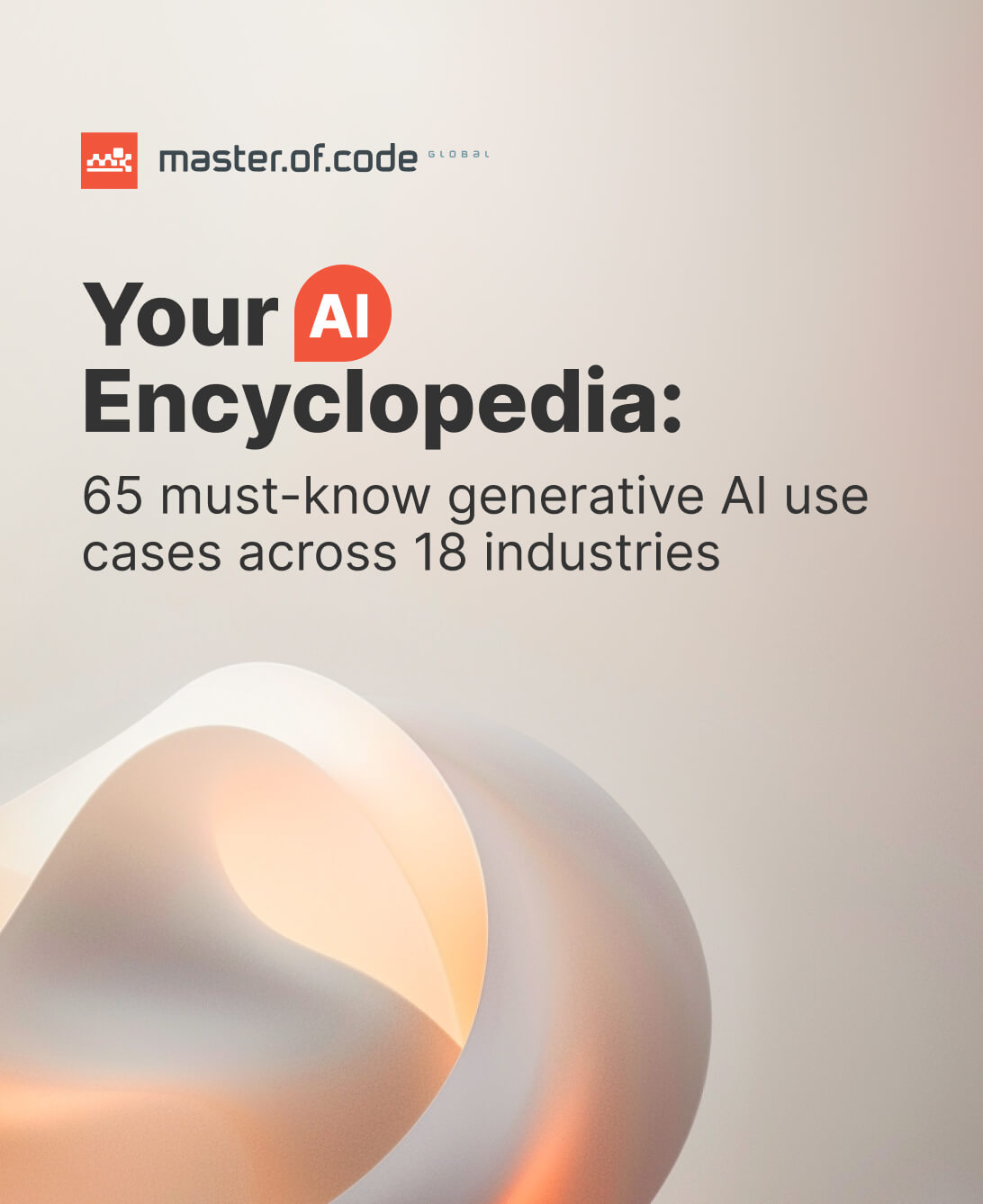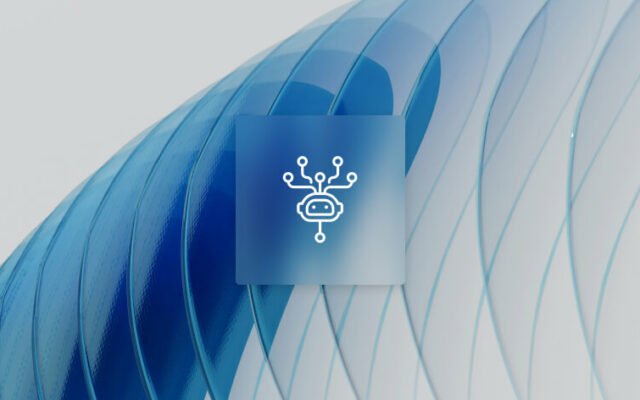The year 2022 marked a watershed moment in the evolution of artificial intelligence. OpenAI’s ChatGPT burst onto the scene and swiftly captivated the world. It’s hard to find someone who hasn’t either experimented with it or at least heard whispers of its capabilities. From content creation and data analysis to coding, creative pursuits, homework assistance, and marketing materials, its applications seem limitless.
The technology’s value across industries is undeniable, as businesses increasingly seek ways to elevate client experiences and streamline operations. AI-powered tools are becoming go-to solutions for automating customer service and delivering personalized support. To better understand this rapidly evolving landscape, we’ve compiled a collection of mind-blowing ChatGPT statistics. Join us as we look into the data and determine whether the hype truly lives up to reality.
Generative AI Across 18 Industries: Unlock 65 must-know AI use cases driving transformation across 18 key industries today.
Table of Contents
Our Picks: 10 ChatGPT Statistics Every Business Leader Should Know
The numbers surrounding OpenAI’s model are nothing short of impressive. Here are 10 key facts that illustrate its capacity and offer valuable insights for businesses considering ChatGPT integration.
- 49% of companies are currently employing this chatbot, with 93% of existing users planning to expand its usage.
- Over 80% of Fortune 500 enterprises have integrated ChatGPT into their workflows within nine months of its launch.
- 64% of journalists, 63% of software developers, and 65% of marketing professionals utilize the system.
- Tools like ChatGPT could increase customer service productivity by 30-45%.
- It may boost marketing output by 5-15% of the total spend.
- Firms investing in AI are seeing a revenue growth of 3-15%.
- A quarter of American companies have saved between $50,000 and $70,000 using GPTs, with 11% saving over $100,000.
- The model is available in 161 countries and has 100 million active users, with an estimated 10 million queries daily.
- 64% of customers are open to buying products recommended by the technology.
- 67% of consumers believe they could benefit from receiving medical advice from Large Language Models (LLMs).
Key ChatGPT Statistics and Trends: 2026 Overview
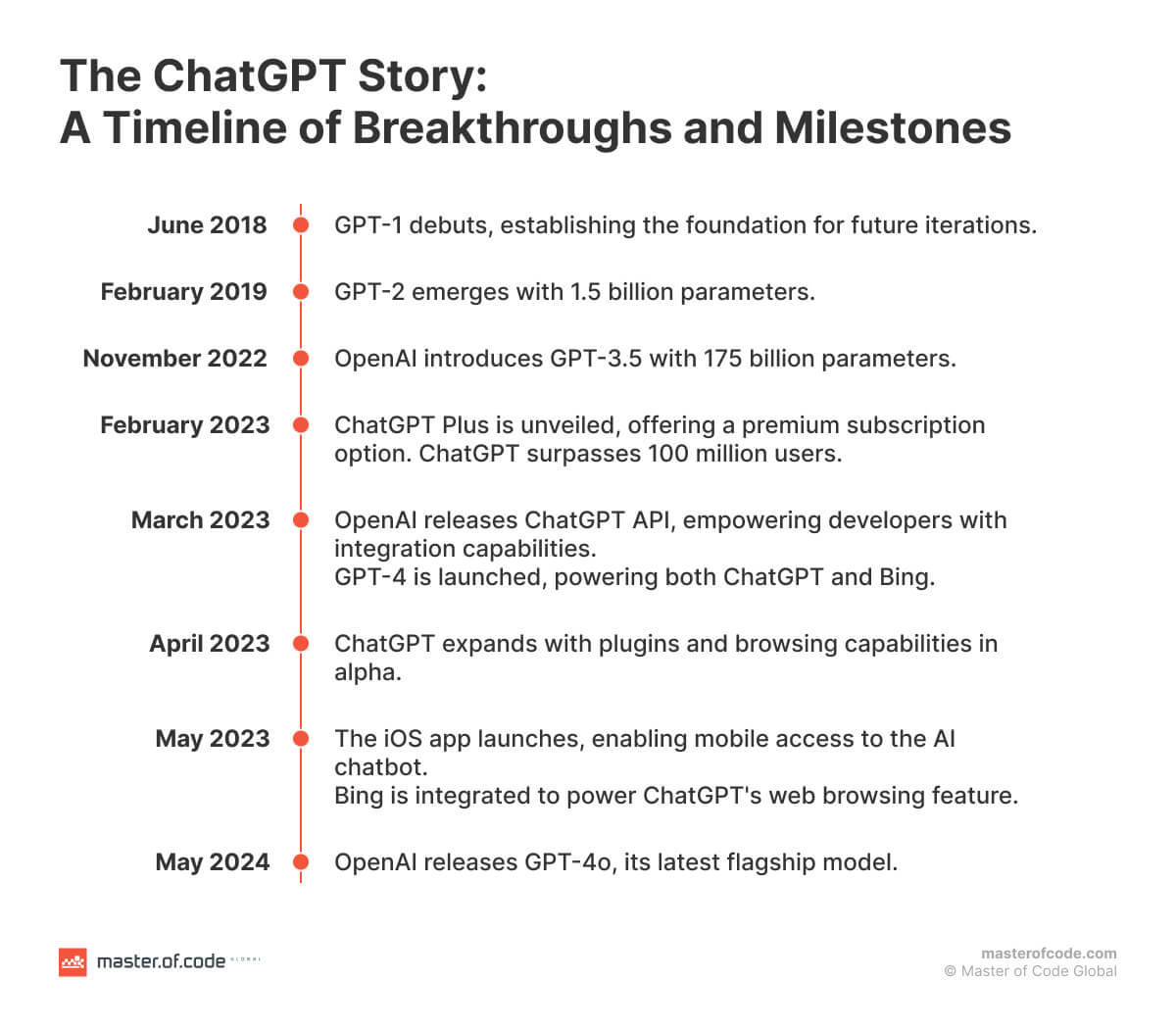
Versions of ChatGPT in Numbers
The model’s phenomenon we see today is the apex of years of research and engineering. Let’s journey through the timeline of key moments that shaped this AI powerhouse:
2018
OpenAI introduced the first version of ChatGPT – the Generative Pre-trained Transformer series or GPT-1. This model demonstrated the potential of transformers combined with unsupervised pre-training to perform diverse language tasks such as commonsense reasoning and reading comprehension with minimal task-specific adjustments.
2019
GPT-2 features 1.5 billion parameters, a tenfold increase over its predecessor GPT-1. Trained on a dataset of 8 million web pages, it excels in generating coherent output and performing assignments like machine translation and summarization. Its accuracy rates range from 63% to 93% on various benchmarks.
2020
GPT-3, an autoregressive LLM with 175 billion parameters, is 10 times larger than any previous non-sparse model. It often nears the performance of state-of-the-art fine-tuned systems and generates high-quality text samples. In 2021, GPT-3 was used by over 300 applications thanks to OpenAI API, producing an average of 4.5 billion words per day.
2022
ChatGPT, fine-tuned from a model in the GPT-3.5 series completed in early 2022, uses Reinforcement Learning from Human Feedback (RLHF) for training. This popular AI chatbot quickly reached 100 million users within two months of its launch. In January alone, it recorded about 590 million visits.

2023
- GPT-4 is designed to be safer and more aligned, with a 6-month development period focused on these aspects. It is 82% less likely to respond to disallowed content and 40% more likely to produce factual responses compared to GPT-3.5. GPT-4 can handle over 25,000 words, making it ideal for long-form materials creation, extended conversations, and document search and analysis.
- OpenAI added support for plugins in ChatGPT. The first 11 were created by Expedia, FiscalNote, Instacart, KAYAK, Klarna, Milo, OpenTable, Shopify, Slack, Speak, Wolfram, and Zapier. By 2024, the number of official plugins had grown to 1,039. These apps enhance the bot’s functionality across multiple use cases.
- In response to user demand for mobile access, OpenAI has launched the ChatGPT application for iOS. Within 24 hours, the solution climbed to the #1 spot on the App Store’s Top Charts list in the United States.
- DALL-E 3, integrated with GPT-4, can generate images based on the prompts. Over 70,000 businesses and brands employ it to create unique graphics. The model was taught with approximately 650 million image-text pairs and is expected to manage up to 4 petabytes of data by 2024.
2024
- GPT-4o is a new flagship model capable of real-time reasoning across audio, vision, and text. It can reply to audio inputs in as little as 232 milliseconds, which is comparable to human response time in conversation. Additionally, it is 50% cheaper to utilize in the API.
- GPT-4o Mini is touted as the most cost-efficient small version. It scores 82% on the MMLU benchmark and currently outperforms GPT-4 on the LMSYS leaderboard for chat preferences. Priced at $0.15/million input tokens and $0.60/million output tokens, it is over 60% more affordable than GPT-3.5 Turbo.
2025
- OpenAI launched ChatGPT Agent, enabling autonomous AI with proactive task execution from a toolbox of functions.
- August 7, 2025 – GPT-5 release. The latest version introduced a unified architecture for text, images, audio, and video without model switching. It supports an expanded context window (up to 272K tokens, or 1M in some variants), stronger reasoning, agentic workflow execution, and advanced multimodal input. GPT-5 also features personalized memory recall (“Memory 2.0”), improved safety through more reliable refusals, and multiple reasoning modes to balance speed, cost, and complexity.
These ChatGPT statistics prove the trajectory of the model is nothing short of remarkable. As we’ve seen, each iteration brings unique possibilities and advantages.
Adoption Specifications

OpenAI’s model popularity isn’t just anecdotal; it’s backed by concrete data:
- By July 2025, 700 million people were sending 18 billion messages each week — roughly 10% of the global adult population. Non-work inputs have grown at a faster pace and now make up more than 70% of all consumer applications.
- Nearly 80% of GPT usage falls into three categories. Practical guidance includes tutoring, how-to advice, and ideation. Seeking information covers queries about people, events, products, and recipes. Writing is the dominant work use case, making up 40% of work messages. Education also stands out, with tutoring requests accounting for about 10% of all activity.
- It handles 10 million queries daily, with users spending an average of 13 minutes and 35 seconds per web session.
- The AI chatbot is available in 161 countries. In the United States, 72.1% of citizens are familiar with ChatGPT, while 30.7% actively use it.
- As of June 2023, 10.8% of global employees had integrated it into their work.
- Adoption rates range from 34% to 79% across different professions for both personal and professional usage.
- A Fishbowl survey indicated that 43% of professionals employed AI tools for diverse tasks, with 68% choosing not to inform their supervisors.
- ChatGPT Plus, the premium subscription, has seen significant growth, reaching 3.9 million active subscribers in the US by March 2024, a substantial rise from 2 million in July 2023.
- However, adoption isn’t consistent across all demographics. Statista revealed that only 12% of American adults used the model to generate text, with 43% of female respondents reporting no interaction with it. Interestingly, 38% of all participants witnessed others using the AI.
- The most popular application of ChatGPT is writing extended prose, such as essays and articles (6.1%), followed closely by crafting emails and letters (5.4%). Creative works, including songs, poetry, and novels, garnered 4.1% of responses. Other notable uses include social media posts (3.4%), speech writing (3.2%), translation (3.0%), and even assistance with dating app communication and profiles (1.9%). Job applications (1.8%), coding (1.3%), marking exams/coursework (0.9%), and cooking (0.7%) also found their place in the answers.
These figures highlight ChatGPT’s rapid integration into various aspects of our lives, both professionally and personally. As technology continues to advance, its potential to reshape industries and individual experiences is undeniable.
ChatGPT Revenue and Usage Statistics
Queries Per Day (Usage Volume)
ChatGPT now receives 2.5 billion prompts globally every day, with about 330 million coming from the U.S. Back in December 2025, OpenAI CEO Sam Altman reported over 1 billion daily queries. This number has since more than doubled. Today, the model has over 300 million weekly active members.
Total Monthly ChatGPT Users in 2026
| Month | Users |
|---|---|
| Jan 2025 | 481 million |
| Feb 2025 | 483 million |
| Mar 2025 | 501 million |
| Apr 2025 | 541 million |
| May 2025 | 603 million |
| Jun 2025 | 723 million |
| Jul 2025 | 812 million |
| Aug 2025 | 838 million |
A significant portion of the traffic (71.9%) originates from YouTube, followed by WhatsApp Webapp (7.0%) and Facebook Desktop (6.9%). Moreover, the bounce rate stands at 31.5%, with users averaging 4.5 pages per visit and spending roughly 8 minutes per session.
ChatGPT Users Demographics
The audience of chat.openai.com is 55.31% male and 44.69% female, as of August 2025. The largest visitor segment falls into the 25–34 age group (29.93%), followed by 18–24 (22.55%), 35–44 (19.89%), 45–54 (13.61%), 55–64 (8.52%), and 65+ (5.49%).
Interestingly, professionals in higher-paid technical and knowledge-driven roles are significantly more likely to employ GPT at work. Adoption rates reach 57% in computer-related fields, 50% in management and business, 48% in engineering and science, and 44% in other professional roles, and just 40% across non-professional occupations.
Work-related usage is also strongly tied to education level. 45% of US. adults with postgraduate degrees use ChatGPT daily, compared with just 17% of those with a high school diploma or less. Similarly, individuals with higher education – 34% with a bachelor’s and 39% with a postgraduate degree – are the most likely to turn to the chatbot for learning.
In the U.S., generational adoption of language models in the workplace is fairly even, with Gen Z at 29%, Gen X at 28%, and Millennials at 27%. The country boasts an estimated 77.2 million monthly active users. Notably, ChatGPT enjoys high retention, with over 89% of paying customers continuing their subscriptions after one quarter and 74% after three quarters (Earnest Analytics).
Its appeal extends beyond personal usage. Over two million developers utilize the platform, and more than 92% of Fortune 500 companies have integrated it into their operations.
Regional User-Based СhatGPT Statistics: USA, Europe, Global
The model is accessible in 161 countries worldwide.
It is banned in 15 nations, with Italy being the first to impose a ban, followed by areas such as China, Iran, and Russia. Additional restrictions apply in places like Cuba, North Korea, and Syria.
Adoption growth in low- and middle-income countries is over 4× that in high-income countries.
Geographically, the top traffic contributors in August 2025 are Japan (39.86%), China (11.44%), India (7.57%), the United States (6.85%), and Australia (2.21%), while all other regions collectively account for 32.08% of visits.
| Country | Daily Use | Weekly Use | Monthly Use |
|---|---|---|---|
| United States | 7% | 11% | 4% |
| Denmark | 3% | 8% | 9% |
| United Kingdom | 2% | 7% | 6% |
| Argentina | 5% | 7% | 5% |
| France | 2% | 7% | 5% |
| Japan | 1% | 5% | 4% |
As for the global user base, it is concentrated in a few key markets: the United States accounts for 19.01%, followed by India (7.86%), Brazil (5.05%), Canada (3.57%), and the United Kingdom (3.48%), while all other countries together make up the remaining 61.03%.
ChatGPT Revenue 2023–2026
| 2023-05 | 2023-11 | 2024-01 | 2024-04 | 2024-08 | 2024-12 | 2025-01 | 2025-02 | 2025-03 |
|---|---|---|---|---|---|---|---|---|
| $0.73M | $7.03M | $12.76M | $16.44M | $26.54M | $59.78M | $70.39M | $75.24M | $108.05M |
ChatGPT Downloads 2023–2026
| 2023-05 | 2023-09 | 2023-11 | 2024-02 | 2024-08 | 2024-09 | 2024-10 | 2024-11 | 2025-02 | 2025-03 |
|---|---|---|---|---|---|---|---|---|---|
| 4.30M | 14.95M | 21.28M | 17.54M | 24.50M | 36.55M | 46.28M | 42.53M | 44.69M | 64.27M |
OpenAI Valuation 2022–2026
The company’s worth has accelerated dramatically between 2022 and 2026. In December 2022, it was valued at around $20 billion, rising to $29 billion by February 2023. Just a year later, in February 2024, its valuation nearly tripled to $80 billion.
By October 2024, OpenAI announced it had raised $6.6 billion in funding at a $157 billion post-money value. Only a few months later, in March 2026, the firm secured a record $40 billion round led by SoftBank, pushing its worth to $300 billion.
OpenAI Funding Rounds 2016–2026
| Date | Funding Type | Number of investors | Money Raised | Lead Investor |
|---|---|---|---|---|
| Mar 31, 2025 | Venture | 16 | $40,000,000,000 | Softbank |
| Oct 2, 2024 | Venture | 9 | $6,600,000,000 | Thrive Capital |
| Oct 3, 2024 | Debt Financing | 16 | $4,000,000,000 | – |
| Feb 16, 2024 | Secondary Market | 5 | $9,500,000,000 | Thrive Capital |
| Apr 28, 2023 | Secondary Market | 10 | $300,000,000 | Andreesen Horowitz, K2 Global, Sequoia Capital, Thrive Capital |
| Jan 10, 2023 | Corporate Round | 1 | $10,000,000,000 | Microsoft |
| Mar 11, 2019 | Seed | 2 | — | Khosla Ventures, Reid Hoffman Foundation |
| Jan 1, 2021 | Secondary Market | 2 | — | Tiger Global Management |
| Aug 22, 2016 | Pre-Seed | 1 | $120,000 | Y Combinator |
ChatGPT Statistics: Market Performance and Financial Impact
Cost of Running ChatGPT
- Daily costs range from $100,000 to $700,000 – The lower figure reflects Microsoft Azure pricing at $3/hour for A100 GPU clusters, while the higher estimate comes from 2023 SemiAnalysis research. OpenAI runs over 3,600 servers to power the platform.
- Individual queries cost 1 cent to $1,000 – Basic responses cost about 1 cent each, but advanced models like o3 can cost up to $1,000 per query. Query prices jumped from 36 cents in 2023 as algorithms became more complex.
- OpenAI loses money on $200 Pro plans – CEO Sam Altman admitted in January 2026 that the company records a loss on its premium subscriptions because users consume more resources than expected.
- Hardware drives most expenses – ChatGPT requires at least 8 NVIDIA A100 GPUs per instance. More sophisticated models need exponentially more computing power, making them far more expensive to operate.
Regional Market Share
According to ChatGPT global statistics, the model dominates the market with 82.7% of share. Perplexity follows at 8.2% (down from 14.1% in March 2025). Other players: Microsoft Copilot (4.5%), Google Gemini (2.2%), DeepSeek (1.5%), Claude (0.9%).
- US & India: 16% each.
- Latin America: Brazil (5.8%), Mexico (4.1%), Colombia (1.6%), Argentina (1.3%)
- Europe: France (4.3%), UK (3.7%), Spain (3.7%), Germany (2.4%), Italy (2.5%), Netherlands (1.1%).
- Asia-Pacific: Philippines (2.5%), South Korea (1.1%), Australia (1.8%).
- Canada: 5.4%.
Competitor Comparison: ChatGPT vs. Gemini vs. Claude
| Model | Input Cost / 1M tokens | Output Cost / 1M tokens | Speed (tokens/s) | Latency (s) | GPQA (%) (reasoning) |
|---|---|---|---|---|---|
| GPT-5 | $1.25 | $10.00 | N/A | N/A | 87.3 |
| Claude Opus 4.1 | $15.00 | $75.00 | N/A | N/A | 80.9 |
| Grok 4 | N/A | N/A | 52 | 13.3 | 87.5 |
| Gemini 2.5 Flash | $0.15 | $0.60 | 200 | 0.35 | 78.3 |
| GPT o4-mini | $1.10 | $4.40 | 135 | 35.3 | 81.4 |
| Llama 4 Scout | $0.11 | $0.34 | 2,600 | 0.33 | N/A (not listed) |
| DeepSeek-R1 | $0.55 | $2.19 | 24 | 4.0 | 71.5 |
Data and Statistics on ChatGPT Adoption & Benefits
ChatGPT in Business
As was mentioned above, 49% of companies employ the model. A quarter has already saved more than $75,000 from its usage. Confidence in the technology is strong, with 93% of existing users intending to expand their reliance on ChatGPT. At the same time, 90% of business leaders view ChatGPT experience as a valuable skill for job seekers.
Business Owner Perspectives as per Forbes Research
- Overall optimism and impact. An impressive 97% of leaders believe GPT will have a positive influence on their operations. Within the next year, 90% anticipate improvements, highlighting benefits such as enhanced decision-making (48%), increased credibility (47%), and more efficient processes (53%). Moreover, 55% of business leaders rate ChatGPT’s work quality as “excellent” and 34% as “very good.”
- Customer engagement and marketing. The OpenAI model is viewed as an invaluable instrument for enhancing interactions, with 58% of entrepreneurs anticipating a more personalized experience. Additionally, 74% intend to employ it for generating chatbot responses, 30% for writing website content, and 57% predict it will boost web traffic.
- Content creation and communication. The potential of ChatGPT in text generation is recognized by 70% of business owners, who acknowledge it helps generate materials quickly. The bot is also seen as an effective tool for communication, with 46% expecting it to streamline email correspondence and 44% planning to use it for multilingual writing.
- Technical and operational applications. Beyond marketing, 41% of company founders foresee introducing the LLM to correct coding errors, while 53% consider it valuable for summarizing information.
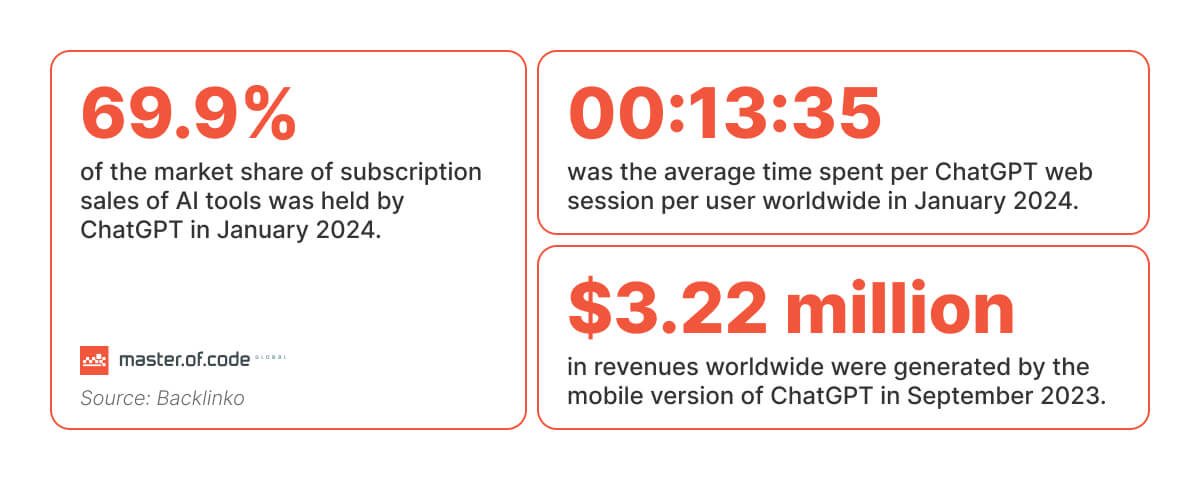
ChatGPT Key Statistics: Application Areas
General research remains the top use case for ChatGPT at 36.6%, followed by academic research (18.1%), coding assistance (14.1%), and email composition (13.8%). Smaller but notable applications include commercial research (5.0%), marketing copywriting (4.4%), and other uses (8.0%), highlighting the platform’s versatility across both professional and personal tasks.
ChatGPT is driving major purchasing influence across industries, with travel and hospitality leading at 18% of customers and an estimated $1.48 trillion impact. Retail and CPG (16%, $1.11 trillion) and IT services (14%, $936 billion) follow closely, highlighting strong adoption in consumer-facing and digital sectors.
Lifestyle, health and wellness (13%, $891 billion) and food and beverage (13%, $546 billion) also see significant financial impact, while industries like automotive, B2B SaaS, and healthcare each generate hundreds of billions.
Even traditionally slower adopters such as real estate, financial services, and education are showing measurable traction, underscoring model’s expanding role in global commerce.
The business landscape is undoubtedly being reshaped by GPTs. But how is this transformation playing out across specific industries? Let’s examine more ChatGPT statistics to see how the model is making its mark in diverse sectors.
Quantifying ChatGPT Influence on Key Business Functions
Customer Service
- OpenAI’s chatbot is increasingly preferred by consumers for product and service recommendations, with 70% turning to Generative AI tools like it over traditional search methods.
- 43% of buyers desire widespread implementation of Gen AI in their interactions with companies, while 62% are comfortable with such systems used in marketing and advertising as long as it doesn’t negatively impact their experience.
- The technology has showcased the ability to significantly improve customer service efficiency, with research showing a 14% increase in issue resolution and a 9% reduction in handling time at one company.
- The potential value of applying solutions powered by ChatGPT or other models to client care is estimated to be between 30% and 45% of current function costs.
Marketing & Advertising
- 67% of CMOs are exploring personalization through Generative AI, followed by content creation (49%) and market segmentation (41%). Moreover, 93% of them report immediate positive or very positive improvements in work organization, with 91% seeing a boost in efficiency.
- Initial observations suggest that ChatGPT-like technology’s ease of use and low cost can lead to productivity gains of up to 30%.
- The calculated benefits of adopting Gen AI in marketing could be between 5 and 15% of total spending.
Sales
- Firms investing in AI are experiencing a 3 to 15% revenue and a 10 to 20% ROI uplift.
- Integrating smart algorithms could result in elevated effectiveness of approximately 3 to 5% of present global sales expenditures.
- Across 63 use cases, the technology may generate $2.6 trillion to $4.4 trillion in value across industries.
HR and Recruiting
- Adoption of AI in HR is still maturing: 40% are in the implementation stage, while 25% are piloting and another 25% are actively operating smart tools.
- HR teams are prioritizing data-driven decision-making (66%), improving work quality (58%), and freeing up time for strategic tasks (51%), with cost savings and customer satisfaction as additional goals.
- AI is also most commonly applied in talent acquisition for sourcing candidates (40%), while nearly half of organizations (42%) still don’t use tech in this area.
- In the recruitment process, top uses include creating job descriptions (30%), candidate communication (25%), and interview scheduling or resume screening (23%).
ChatGPT Stats 2026: How Industries Are Leveraging AI
The model’s impact is not limited to a single domain. Its versatility has resulted in widespread integration across various industries, with some embracing the technology more readily than others. Data indicates that in 2023, the technical sector led in ChatGPT usage with 251 companies incorporating it, followed by education (209) and business services (98). Other spheres like finance (44), retail (35), and healthcare (24) are also seeing growing adoption.
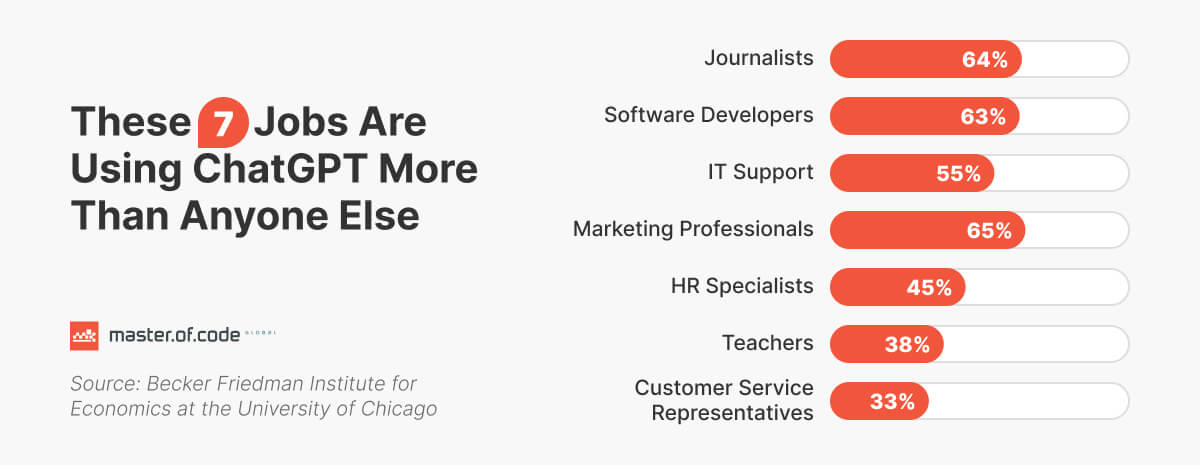
Within these industries, certain professions are at the forefront of AI utilization. A survey reveals that journalists (64%), software developers (63%), and marketing professionals (65%) are among the most frequent users. Let’s explore how this innovative tool is transforming the way they work across diverse sectors.
Healthcare
Global Acceptance
- 67% of customers worldwide think they could benefit from receiving medical advice from LLMs.
- 63% of people express excitement about the potential of ChatGPT to accelerate drug discovery and development.
- In a blind study, licensed care professionals preferred chatbot answers 79% of the time, citing higher quality and empathy compared to physician responses.
Healthcare Worker Perspectives (HCWs)
- 18.4% of HCWs have used ChatGPT for healthcare purposes, whereas 84.1% of those not currently employing it show enthusiasm for utilizing AI chatbots in the future. At the same time, 75.1% of the experts are comfortable incorporating the system into their practice.
- HCWs perceive the model’s usefulness in various areas: decision-making (39.5%), patient and family support (44.7%), literature appraisal (48.5%), and research assistance (65.9%).
- Moreover, 76.7% of medical specialists assume the LLM could positively impact the overall sector.
Consumer Interest in Healthcare Applications
- 60% of people would be open to getting medical recommendations from ChatGPT, while 57% would consider using it as a free therapist.
- 67% believe this bot could help individuals with certain mental impairments study more effectively.
Read also: additional healthcare statistics and see how the technology is applied in real-world scenarios
eCommerce and Retail
- Consumers are increasingly receptive to Generative AI tools, like GPT-4, in their shopping journey, with 64% inclined to purchase products and services based on its suggestions. Furthermore, 67% anticipate personalized tips for fashion and home decor, demonstrating the potential for technology to enhance buyer experiences.
- ChatGPT has outperformed other retail chatbots, with 67% of shoppers finding it more effective at understanding their queries.
- eCommerce marketers are experiencing significant benefits from language models. 83% of them report increased productivity and 84% enhanced performance. Many express a desire to employ AI for tasks like marketing analytics (49%), competitor assessment (49%), and customer behavior prediction (47%). 41% of specialists highlight improved quality and accuracy as a key advantage of intelligent solutions.
- ChatGPT’s ability to interpret information has proven valuable in the industry, with a reported 30% increase in effectiveness when utilized for data analysis (EComRevenueMax).
Hospitality and Travel
- 60% of hotels are open to technological innovations, with 64% having already experimented with instruments like ChatGPT. Moreover, 49% of them intend to integrate the technology into their operations in 2024.
- 51% of hoteliers consider the primary benefit of AI to be boosted efficiency in different aspects of hotel management. 18% of them expect that intelligentization will enrich the user experience through chatbots and virtual assistants.
- 97.8% of travel executives assume AI will significantly impact the sector in the next five years. Similarly, 86% of CEOs believe that it becomes a mainstream technology at their companies within the same period.
- 32% of U.S. travelers are likely to use GPTs to plan a trip. In fact, 281 out of 300 surveyed tourists revealed using the model at various stages of their planning. For example, 29.6% used it for pre-trip purposes.
Finance and Banking

- 80% of client-facing banking professionals believe ChatGPT could assist in their daily tasks.
- 68% of officers anticipate increased spending on AI technology at their institutions.
- 70% of financial experts perceive their banks as not being advanced in using Gen AI compared to competitors.
- 62.5% of specialists foresee a 0-19% efficiency gain through GPT implementation.
- 49% of bankers estimate cost savings of 2-5% of annual industry costs through such models.
- 53% of consumers trust AI-assisted financial planning.
Education & EdTech
Based on the recent Generative AI Survey 2025 by HEPI:
- Student adoption of machine intelligence has risen sharply, with 92% using tools like ChatGPT in 2026 compared to 66% in 2024, and 88% turning to GenAI for assessments, up from just 53% the previous year.
- The most common applications include explaining concepts, summarizing articles, and generating research ideas, though 18% of students admit to inserting AI text directly into their work.
- Institutions are strengthening their oversight, as 80% now report having a clear policy and 76% believe they can detect artificial intelligence use in assessments, both improvements on 2024.
- Despite students valuing AI skills, only 36% receive institutional support to develop them, even as staff preparedness has grown from 18% in 2024 to 42% in 2026.
- New survey insights show that 45% used this tech in school, 40% believe synthetic content could earn good grades, and opinions on AI-assessed exams remain mixed, with roughly a third saying they would work harder under such conditions.
Legal and Professional Services
According to Thomson Reuters Institute:
- 41% of professionals now use public tools like ChatGPT and 17% – industry-specific platforms. Organizational adoption has nearly doubled to 22% in 2026, with half of firms still planning or debating implementation.
- Only 13% currently see GenAI as central to operations, but 29% expect it will be within a year. An overwhelming 95% believe it will be core to their organization in the next five years.
- Sentiment remains positive, with 55% of respondents feeling excited or hopeful, hesitancy declining by 12 points year-over-year, and 89% saying they already identify practical GenAI applications in their work.
- Business value is less clear: only 20% of organizations measure ROI from GenAI, while many clients want firms to use the technology, but are often unsure whether they actually do.
- Policies and training lag behind adoption. 52% of individuals say their companies lack GenAI policies, and 64% report receiving no training, underscoring gaps in governance and enablement.
ChatGPT Concerns and Risks: Navigating the Challenges
Job Displacement Concerns
- 32% of business leaders in the United States foresee ChatGPT causing more layoffs within the following 5 years.
- 38% of chatbot users express fear of AI replacing human jobs.
- 39% of employees are concerned about not receiving sufficient training in digital and technology skills from their employers.
Data Security and Privacy Risks
- 9.3% of knowledge workers have used the GPT model in the workplace, and 7.5% have pasted data into it.
- Since its launch, 4.0% of employees have inputted sensitive information into ChatGPT, representing 11% of all submitted content.
- The number of incidents involving such data being leaked to the system increased by 60.4% between February and April 2023. The most common types of confidential details shared with the bot are private/internal data, source code, and client records.
- 87.8% of surveyed individuals believe chatbots could be exploited for malicious purposes, such as collecting personal info or manipulating users.
- 80% of participants in a study agreed that cybercriminals use ChatGPT for deceptive activities.
Read also: top LLM security threats based on insights from Anhelina Biliak, our Application Security Leader
Bias and Misinformation
- Research indicates that the model’s toxicity can increase up to six times when assigned a persona, leading to the endorsement of stereotypes, harmful dialogue, and hurtful opinions.
- Certain entities, such as specific races, are three times more likely to be targeted by damaging outputs, regardless of the programmed personality.
- 74% of IT decision-makers acknowledge and are alarmed by the potential cybersecurity threat posed by GPT-4.
- ChatGPT has falsely accused an American law professor of sexual harassment and claimed an Australian mayor was imprisoned for bribery, both based on non-existent reports.
- The prevalence of hallucinations (generating false facts) in large language models is estimated at 15% to 20%.
- A New York lawyer cited fake cases generated by ChatGPT in a legal brief filed in federal court.

Legal and Ethical Concerns
- 15% of respondents in a survey of law firms reported receiving warnings about using LLMs at work, with 6% stating outright bans on unauthorized usage.
- 85% of the research participants agreed that the system is vulnerable to cybersecurity issues. Whereas 82% of them expressed concern about the possibility of malicious use to make fake news, impersonate individuals, or spread disinformation.
- 81% were worried about attackers manipulating ChatGPT to create convincing phishing emails.
- 75% of respondents indicated that the chatbot poses security risks, such as being hacked or compromised. And 89% were even concerned about it having access to sensitive information that could be misused.
- Overall, 80% believed that ChatGPT represents a major risk to data protection and privacy.
Read also: Our security team’s guide can help ensure ChatGPT enhances your operations, not endangers them
Accuracy and Originality Challenges
- OpenAI’s LLM has been shown to achieve only 50% accuracy on questions that humans are prone to answer incorrectly.
- Adding incorrect details to prompts can decrease the model’s precision by nearly 30%.
- Detection tools have found statistically significant text sources in ChatGPT’s written answers, with plagiarism rates of up to 50%.
As per RegASK’s 2025 report:
- 43% of senior executives expect AI-related regulations to increase.
- Just 63% of senior regulatory leaders are confident their organizations are fully compliant and that the data they rely on is accurate.
- Among these professionals allowed to use ChatGPT, 53% have used it for adherence guidance, but only 22% express full trust in its responses.
According to the recent study, evaluating GPT’s data protection compliance is difficult due to limited transparency, unclear data use, and evolving privacy policies. Personal information is likely included in training datasets, raising concerns about purpose limitation and the “right to be forgotten.”
The Future of ChatGPT
- By 2026, global search engine traffic will fall by 25%, as AI chatbots and virtual agents take over a larger share of search marketing.
- As early as 2026, LLMs could begin generating new discoveries and ideas, and by 2027, humanoid robots may be capable of performing human-like work both online and offline.
- By 2027, AI-driven search is expected to generate as much global economic value as traditional search and could surpass it in later years.
- AI assistants will handle most queries, with projections showing ChatGPT’s traffic overtaking Google’s by October 2030.
- By 2026, three-quarters of businesses will use Generative AI to create synthetic customer data, up from less than 5% in 2023.
- By 2027, more than half of enterprise models will be industry- or function-specific, compared to just 1% in 2023.
- By 2027, generative technology will drive over half of asset selection within tech marketplaces.
- By 2028, one-third of GenAI interactions will involve action models and autonomous agents to complete tasks.
- By 2028, 30% of these deployments will use energy-efficient computational methods, driven by sustainability goals.
ChatGPT Statistics FAQ
How many people use GPT in 2026?
As of August, it has around 838 million monthly users, with 300 million people who use ChatGPT weekly. An estimated 700 million individuals send 18 billion messages each week – roughly 10% of the global adult population.
How many ChatGPT queries per day?
It now handles about 2.5 billion prompts daily, more than double the 1 billion daily queries reported by Sam Altman in 2026.
How much revenue does OpenAI make?
According to the recent ChatGPT stats, n-app purchases generated around $108 million in March 2025, up from just $0.73 million in May 2023. Its valuation surged to $300 billion in March 2025 after raising $40 billion in funding.
What are the biggest industries using ChatGPT?
Major adoption is seen across travel & hospitality ($1.48T impact, 18% of customers), retail & CPG ($1.11T, 16%), and IT services ($936B, 14%). Other strong sectors include lifestyle, health & wellness ($891B, 13%), food & beverage ($546B, 13%), with additional traction in automotive, SaaS, finance, healthcare, real estate, and education.
Wrapping Up
The Gen AI phenomenon isn’t just a fleeting trend – it’s a fundamental change in how we interact with technology, as evidenced by the ChatGPT statistics revealed here. From its exponential growth in adoption to the integration across diverse sectors, the model is leaving an undeniable mark. While challenges remain, the data paints a striking portrayal of a tool positioned to reinvent business as we know it.
Looking ahead, companies are embracing ChatGPT as a linchpin in their operations. 70% of firms anticipate it supercharging content creation, 58% see it as a gateway to personalized customer experiences, and 53% believe it will streamline their workflows.
Don’t get left behind. Align with the intelligentization movement and drive your brand forward with unparalleled efficiency, interactive engagement, and innovative thinking. Our team of AI specialists is ready to develop a tailored ChatGPT solution that empowers your employees boosting ROI. Contact us today to start your artificial intelligence journey.
Ready to build your own Conversational AI solution? Let’s chat!


